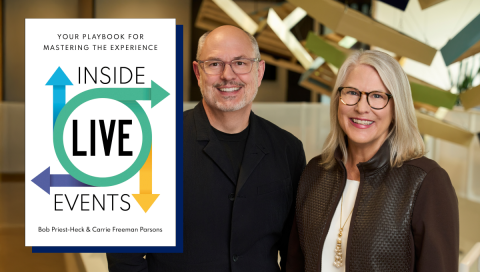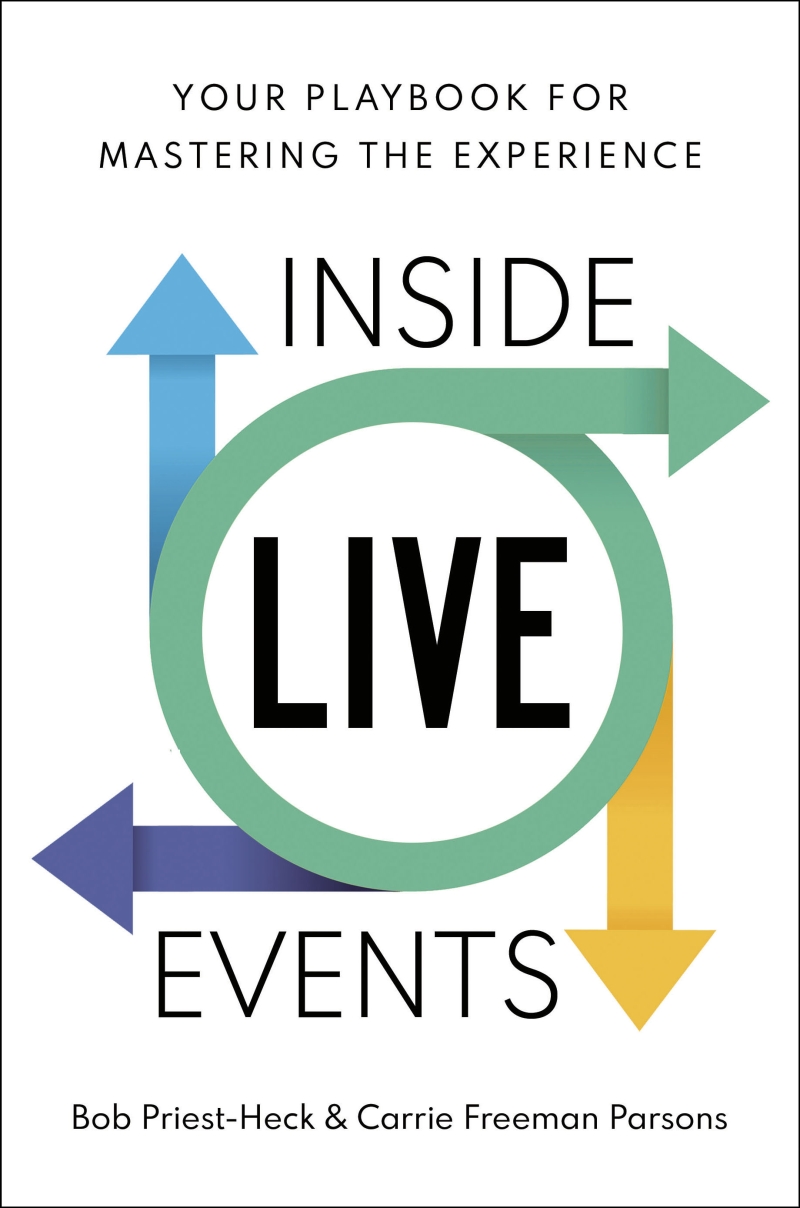11 Lessons Learned from A New Book by Freeman’s Bob Priest-Heck and Carrie Freeman Parsons

Inside Live Events, a new book by co-authors Freeman Board Member Bob Priest-Heck and Freeman Board Chair Carrie Freeman Parsons, debuted yesterday as a comprehensive playbook for creating and producing live events, including trade shows, corporate events, and exhibits.
Back story: With a combined 78 years of event production experience, the authors drew on their decades of knowledge to publish Inside Live Events, designed to serve as a reference for events veterans while equipping newcomers with practical insights and actionable strategies.
Need to know: Offering steps to create meaningful connections and impactful experiences for event professionals at any stage of their careers, the book breaks down the power of live events into a four-phase methodology: getting started, designing the plan, building the plan, and reviewing and improving. With a glossary of industry terms, Inside Live Events shares tips and techniques inspired by the proven strategies the global event solutions company has used for 97 years.
What they’re saying: “Inside Live Events captures the expertise and insights of industry leaders,” said Freeman Parsons, whose grandfather Donald S. “Buck” Freeman opened the first Freeman Decorating Office in 1927. “For event pros, it has checklists and tips that help promote continuous improvement. But it’s also designed to help those new to the industry find a unique career path. It’s like a Masterclass on how to make a meaningful impact through live events. Our goal is to demystify what we do, celebrate the adventure of live events, and help those new to the industry feel more confident.”
Related: Listen to our Trade Show Talk podcast with Bob Priest-Heck published in July 2024

Why it matters: “As an industry veteran, I’ve witnessed the evolution of events and the incredible ways it continues to shape connections, trust, and collaboration,” said Priest-Heck, who served as Freeman CEO for six years until he retired in 2024. “I hope this book will help more people embrace and amplify the power of events to create positive change.”
Related: Freeman Names Janet Dell as CEO When Bob Priest-Heck Retires in July
Big picture: “At Freeman, we believe investing in talent strengthens our entire industry,” said Freeman CEO Janet Dell. “This book reflects our commitment to attracting, developing, and retaining top talent at every career stage. By sharing knowledge and creating opportunities for growth, we're empowering the next generation of event professionals.”
TSNN received an advance copy of the book to review, and we noted hundreds of tips and dozens of comprehensive lists of strategies for creating, producing, and iterating live events.
Is it worth a read? Here are 11 excerpts from Inside Live Events to provide an overview of the content.
- Think like an attendee. “Those of us working in the events industry sometimes forget to think like attendees. Regardless of an event’s purpose or strategic priorities, its true goal should focus on bringing value to attendees. That means the words we use to engage them matter.”
- Design a beautiful event. “Ask the team to describe the most beautiful outcome they can imagine. Everyone on the event team should work to understand what beautiful looks like and implement a plan to get there. Perhaps beautiful looks like a powerful confluence of audience engagement, seamless logistics, stunning visuals, and an unforgettable experience that lingers in the minds of attendees long after they leave the event.”
- Track what’s new. “Always looking for ‘what’s new’ in the world surrounding the event is key to avoiding obsolescence. Examine news reports, white papers, influencer social media posts, and related sources that might point to shifts in trends or interests, whether driven by new technology, sociopolitical concerns, demographic shifts, or any input that signals change.”
- Choose the right partners. “Creating a successful live event that leaves a lasting impression on attendees hinges not just on the internal team’s effort but significantly on the choice of external partners. Choosing the right partners for your event requires careful consideration of their capabilities, experience, adaptability, and alignment with your event’s goals—and is a critical decision. Form partnerships that meet and exceed the expectations for your event, ensuring its success and the satisfaction of all stakeholders involved.”
- Refine your event brand. “To validate the brand relevance of the purpose statement included in the creative brief, substitute the names of other events, associations, or brands. If it works for them, it may not be authentic or specific enough to represent your event’s unique opportunity.”
- Kill your darlings. “Sound advice (originally given to a writer fighting to protect a favorite bit of prose no longer supporting the narrative) is ‘kill your darlings.’ This advice applies to experience design, too. Sometimes we have an idea so amazing, we’re tempted to overlook the fact that it’s a forced fit. Even if it feels painful, we have to let it go.”
- Examine experience touchpoints. “Your event is the sum total of thousands of touch points, each of which can add to or detract from its success. List every point of engagement with a description of the experience. What’s their travel experience? When do they first engage with the event app? Are they greeted at the hotel? What happens when they arrive at the venue? What are their engagement choices?”
- Less may be more. “Look for opportunities to combine two or more activities into a single, stronger activity, eliminating anything extraneous. Identify which concept has the best potential to create a memorable, relevant experience that fulfills your top three objectives. Then run the idea by an extended team of experts inside and outside of your team to validate it.”
- Sponsorship advice. “Make a plan to nurture lower-tier sponsors; gracious support at this level can help build a pipeline of major sponsors for the future.”
- The post-show debrief. “Formulate a plan to gather feedback on the services provided as the event unfolds in order to review the overall success of the event and the performance of each service provider. Determine how this will be documented as part of the debrief phase to inform future planning.”
- Master post-event marketing. “Create compelling recap content: Develop visually captivating infographics that highlight key statistics, moments, and takeaways from the event. Craft engaging blog posts that delve into the most impactful sessions, discussions, and presentations. Collaborate with influencers or industry experts to amplify your post-event marketing efforts.”


Add new comment